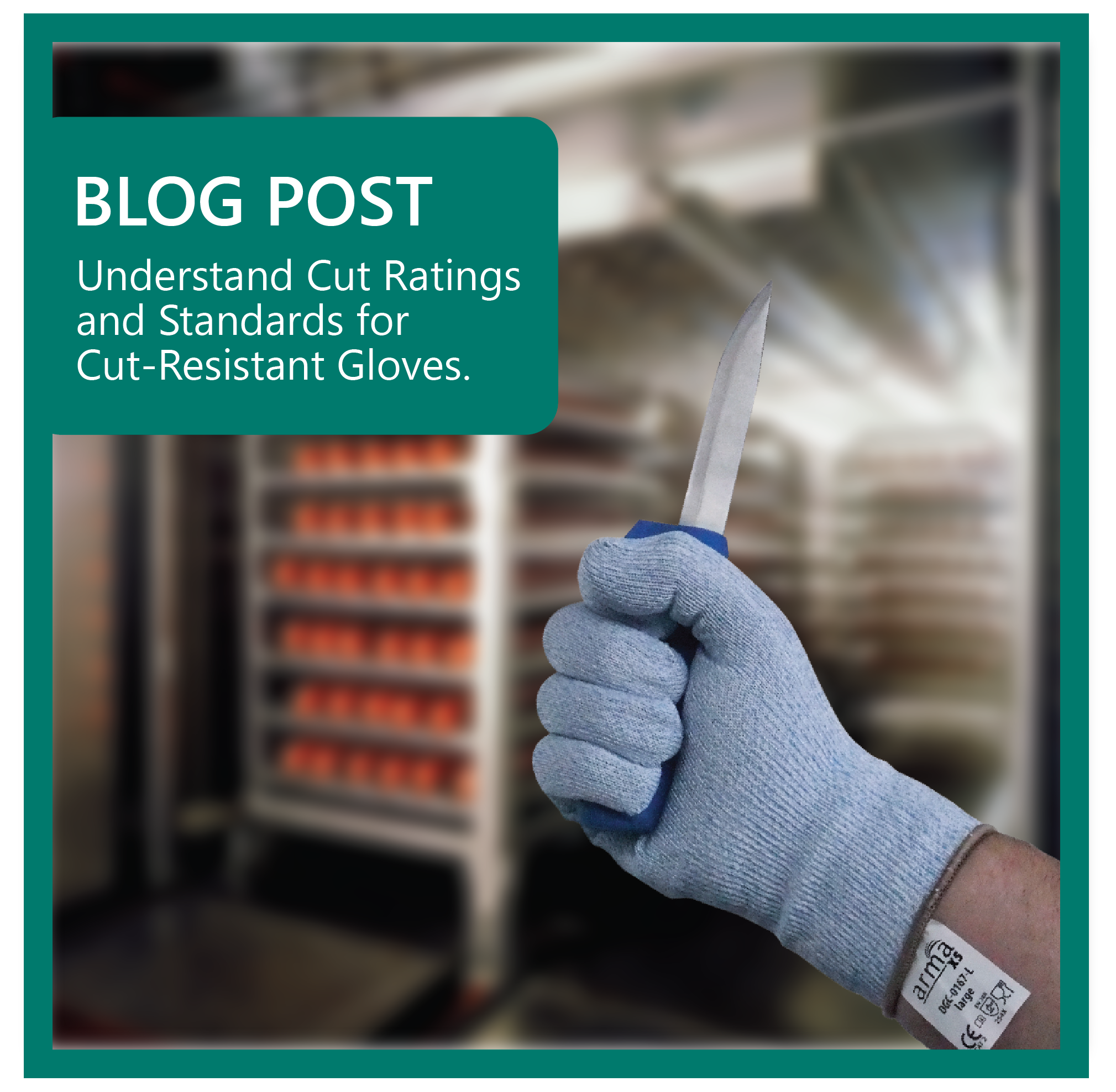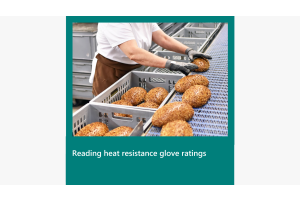Understanding Cut Ratings and Standards for Cut-Resistant Gloves

In the food industry, safety is paramount, and hand protection is no exception. Cut-resistant gloves are a critical component in ensuring worker safety. But with so many ratings and standards out there, it can become confusing to navigate and understand them all. In this blog post, we aim to simplify and explain the different cut ratings and standards, both old and new, that dictate the level of protection offered by cut-resistant gloves.
Understanding Cut Ratings and Standards
Before diving into specifics, it's essential to understand what cut ratings are and why they matter. In simple terms, cut ratings indicate the level of cut resistance offered by a glove. Higher cut ratings mean that the gloves offer better protection against cuts. These ratings are standardized by various bodies, each with different testing methods and rating systems.
1. EN388 (European Standard)
The EN388 standard is a popular and widely used European standard that tests against mechanical risks, including abrasion resistance, cut resistance, tear resistance, and puncture resistance.
Previously, the EN388 cut rating was represented by a single number (1-5), with 5 indicating the highest level of cut resistance. However, since the test was not suitable for all materials, especially those that dull the blade during the test, a new method (ISO 13997 or the 'TDM' Test) was introduced in the 2016 revision of EN388. It's represented by a letter A to F, where F indicates the highest cut resistance.
2. ANSI/ISEA 105 (American Standard)
This standard is by the American National Standards Institute and the International Safety Equipment Association (ANSI/ISEA).
Until 2016, the ANSI/ISEA standard used a similar scale as the old EN388, rating cut resistance on a scale of 1-5. However, in 2016, to provide a more accurate depiction of cut resistance, this standard was updated. The revised scale now rates cut resistance from A1 (least resistant) to A9 (most resistant).
Comparing Old and New Standards
To put it simply, both the European and American standards have moved to more nuanced and accurate cut rating systems.
While the old system (EN388 and ANSI/ISEA 1-5 scale) was straightforward, it didn't account for certain factors, like the glove material dulling the blade during testing, which could lead to overrated cut resistance.
The new systems (EN388 A-F and ANSI/ISEA A1-A9) offer a more accurate depiction of cut resistance by addressing these shortcomings. This gives the users a more reliable indication of the level of protection they can expect from their gloves.
However, it's important to note that these ratings serve as a guide and actual performance may vary based on the specific working conditions.
Choosing the Right Glove
When selecting a cut-resistant glove for use in the food industry, it's crucial to consider the specific tasks to be performed, the risks involved, and the required dexterity. Glove selection should not be based solely on cut ratings. However, understanding these ratings will help ensure that you're choosing a glove that provides the necessary protection for your unique needs.
EN388 (European Standard)
This European standard evaluates gloves for their resistance to abrasion, cut, tear, and puncture. For cut resistance, the latest version (EN388:2016) includes two different tests:
1. Coup Test (Cut Resistance): This test is carried out using a circular rotating blade that moves back and forth across the material under a fixed load. The cut resistance is then determined based on the number of cycles completed before the blade cuts through the sample. This method was suitable for most materials, but for some types of fabric, especially those that can dull the blade during testing, the cut resistance was often overrated. This cut rating is represented by a number from 1 to 5, with 5 providing the highest level of cut resistance.
2. ISO 13997 (TDM) Test: To address the limitations of the coup test, this test method was introduced. It measures the force required to cut through the glove sample at a constant speed. This test is considered more representative of the cut risks in most real-world situations. The TDM cut rating is represented by a letter from A to F, with F providing the highest level of cut resistance.
ANSI/ISEA 105 (American Standard)
This standard, managed by the American National Standards Institute and the International Safety Equipment Association, assesses gloves for their resistance against mechanical and chemical hazards, as well as ignitability, heat degradation, and vibration reduction.
The ANSI/ISEA 105-2016 standard introduced a more detailed scale for cut resistance. Instead of the old 1-5 scale, the standard now includes nine levels (A1 to A9), where A9 provides the highest cut resistance.
The ANSI/ISEA 105-2016 uses a single test method, known as the ASTM F2992-15 test. In this test, a straight blade is drawn across the material under a specified load. The cut resistance is determined by the weight needed to cut through the sample. This test can measure higher levels of cut resistance than the previous test method, and is therefore more suitable for gloves made from advanced materials that offer high cut resistance.
In summary, both standards aim to provide a more accurate measure of cut resistance, especially for gloves made from modern materials. They have introduced new tests and rating scales to provide a better reflection of the protection offered by different gloves, and to help users choose the right glove for their specific needs. Always remember that these cut ratings serve as a guide, and actual performance may vary based on the specific working conditions.
Glove Gauges
In the world of cut-resistant gloves, "gauge" refers to the number of knitting needles per inch. Simply put, a higher gauge means a tighter, denser weave, while a lower gauge means a looser weave. Common gauges in cut-resistant gloves range from 7 gauge (lower) to 18 gauge (higher).
Understanding the influence of glove gauge on comfort and dexterity is essential when choosing the right glove for the task at hand. Here's a closer look at how different gauges affect these parameters:
Higher Gauge Gloves (13-18 Gauge)
Higher gauge gloves, due to their denser weave, tend to be thinner and more flexible. This allows for enhanced dexterity and tactile sensitivity, making them an excellent choice for tasks requiring precision and a delicate touch.
These gloves also tend to be more comfortable for the wearer, conforming better to the shape of the hand and providing a more natural, less bulky feel. They can be worn for extended periods without causing as much hand fatigue as lower gauge gloves.
The thinner construction of higher gauge gloves doesn't necessarily mean they offer less cut protection. Advances in yarn technology mean that very thin, high gauge gloves can still offer significant cut resistance, particularly when constructed from high-performance synthetic materials.
Lower Gauge Gloves (7-10 Gauge)
Lower gauge gloves have a looser knit and are generally thicker and heavier than higher gauge gloves. They are often used for tasks requiring more significant cut protection or for handling heavier or bulkier items.
While they may offer higher levels of cut protection, lower gauge gloves tend to reduce dexterity and tactile sensitivity, which can make them less suitable for tasks requiring a high degree of precision. They may also be less comfortable for extended wear, as they are heavier and bulkier.
In conclusion, the gauge of a cut-resistant glove plays a significant role in comfort and dexterity. A higher gauge glove typically offers better dexterity and comfort, making it ideal for tasks requiring precision. In contrast, a lower gauge glove may offer superior cut protection but may also be bulkier and less comfortable. It's crucial to consider these factors alongside the cut resistance level when selecting the right glove for the job.










